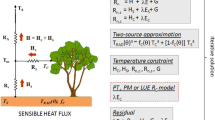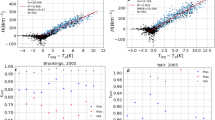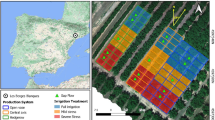ab]Abstract
A two-source model for deriving surface energy fluxes and their soil and canopy components was evaluated using multi-angle airborne observations. In the original formulation (TSEB1), a single temperature observation, Priestley—Taylor parameterization and the vegetation fraction are used to derive the component fluxes. When temperature observations are made from different angles, soil and canopy temperatures can be extracted directly. Two dual angle model versions are compared versus TSEB1: one incorporating the Priestley—Taylor parameterization (TSEB2I) and one using the component temperatures directly (TSEB2D), for which data from airborne campaigns over an agricultural area in Spain are used. Validation of TSEB1 versus ground measurements showed RMSD values of 28 and 10 Wm−2 for sensible and latent heat fluxes, respectively. Reasonable agreement between TSEB1 and TSEB2I was found, but a rather low correlation between TSEB1 and TSEB2D was observed. The TSEB2D estimates appear to be more realistic under the given conditions.
Article PDF
Similar content being viewed by others
Explore related subjects
Discover the latest articles, news and stories from top researchers in related subjects.Avoid common mistakes on your manuscript.
References
Anderson, M.C., J.M. Norman, G.R. Diak, W.P. Kustas, and J.R. Mecikalski (1997), A two-source time-integrated model for estimating surface fluxes using thermal infrared remote sensing, Remote Sens. Environ. 60, 2, 195–216, DOI: 10.1016/S0034-4257(96)00215-5.
Anton, J.A., and J.K. Ross (1987), Emissivity of the vegetation-soil system, Sov. J. Remote Sens. 5, 49–55 (in Russian with English summary).
Brutsaert, W. (1982), Evaporation into the Atmosphere. Theory, History, and Applications, Springer Science & Business Media, Dordrecht, DOI: 10.1007/978-94-017-1497-6, 299 pp.
Campbell, G.S., and J.M. Norman (eds.) (1998), An Introduction to Environmental Biophysics, 2nd ed., Springer, New York.
Choudhury, B.J. (1987), Relationships between vegetation indices, radiation absorption, and net photosynthesis evaluated by a sensitivity analysis, Remote Sens. Environ. 22, 2, 209–233, DOI: 10.1016/0034-4257(87)90059-9.
Choudhury, B.J., N.U. Ahmed, S.B. Idso, R.J. Reginato, and C.S.T. Daughtry (1994), Relations between evaporation coefficients and vegetation indices studied by model simulations, Remote Sens. Environ. 50, 1, 1–17, DOI: 10.1016/0034-4257(94)90090-6.
Colaizzi, P.D., W.P. Kustas, M.C. Anderson, N. Agam, J.A. Tolk, S.R. Evett, T.A. Howell, P.H. Gowda, and S.A. O’Shaughnessy (2012a), Two-source energy balance model estimates of evapotranspiration using component and composite surface temperatures, Adv. Water Resour. 50, 134–151, DOI: 10.1016/j.advwatres.2012.06.004.
Colaizzi, P.D., S.R. Evett, S.A. O’Shaughnessy, and T.A. Howell (2012b), Using plant canopy temperature to improve irrigated crop management. In: Proc. 24th Annual Central Plains Irrigation Conf., 21–22 February 2012, Colby, USA, 203–223.
Corbari, C., W. Timmermans, and A. Andreu (2015), Intercomparison of surface energy fluxes estimates from the FEST-EWB and TSEB models over the heterogeneous REFLEX 2012 site (Barrax, Spain), Acta Geophys. 63, 6, 1609–1638, DOI: 10.2478/s11600-014-0258-x (this issue).
de Miguel, E., M. Jiménez, I. Pérez, Ó.G. de la Camara., F. Munoz, and J.A. Gómez-Sanchez (2015), AHS and CASI processing for the REFLEX remote sensing campaign: methods and results, Acta Geophys. 63, 6, 1485–1498, DOI: 10.1515/acgeo-2015-0031 (this issue).
French, A.N., F. Jacob, M.C. Anderson, W.P. Kustas, W. Timmermans, A. Gieske, Z. Su, H. Su, M.F. McCabe, F. Li, J. Prueger, and N. Brunsell (2005), Surface energy fluxes with the Advanced Spaceborne Thermal Emission and Reflection Radiometer (ASTER) at the Iowa 2002 SMACEX site (USA), Remote Sens. Environ. 99, 1–2, 55–65, DOI: 10.1016/j.rse.2005.05.015.
Gardner, B.R., D.C. Nielsen, and C.C. Shock (1992), Infrared thermometry and the Crop Water Stress Index. I. History, theory, and baselines, J. Prod. Agric. 5, 4, 462–466, DOI: 10.2134/jpa1992.0462.
Gillespie, A., S. Rokugawa, T. Matsunaga, J.S. Cothern, S. Hook, and A.B. Kahle (1998), A temperature and emissivity separation algorithm for Advanced Spaceborne Thermal Emission and Reflection Radiometer (ASTER) images, IEEE Trans. Geosci. Remote Sens. 36, 4, 1113–1126, DOI: 10.1109/36.700995.
Gonzalez-Dugo, M.P., C.M.U. Neale, L. Mateos, W.P. Kustas, J.H. Prueger, M.C. Anderson, and F. Li (2009), A comparison of operational remote sensing-based models for estimating crop evapotranspiration, Agr. Forest Meteorol. 149, 11, 1843–1853, DOI: 10.1016/j.agrformet.2009.06.012.
Huntingford, C., S.J. Allen, and R.J. Harding (1995), An intercomparison of single and dual-source vegetation-atmosphere transfer models applied to transpiration from Sahelian savannah, Bound.-Lay. Meteorol. 74, 4, 397–418, DOI: 10.1007/BF00712380.
Jackson, R.D., S.B. Idso, R.J. Reginato, and P.J. Pinter Jr. (1981), Canopy temperature as a crop water stress indicator, Water Resour. Res. 17, 4,, DOI: 10.1029/WR017i004p01133.
Kalma, J.D., T.R. McVicar, and M.F. McCabe (2008), Estimating land surface evaporation: A review of methods using remotely sensed surface temperature, data, Surv. Geophys. 29, 4–5, 421–469, DOI: 10.1007/s10712-008-9037-z.
Kustas, W.P., and J.M. Norman (1997), A two-source approach for estimating turbulent fluxes using multiple angle thermal infrared observations, Water Resour. Res. 33, 6, 1495–1508, DOI: 10.1029/97WR00704.
Kustas, W.P., and J.M. Norman (1999), Evaluation of soil and vegetation heat flux predictions using a simple two-source model with radiometric temperatures for partial canopy cover, Agr. Forest Meteorol. 94, 1, 13–29, DOI: 10.1016/S0168-1923(99)00005-2.
Kustas, W.P., and J.M. Norman (2000), A two-source energy balance approach using directional radiometric temperature observations for sparse canopy covered surfaces, Agron. J. 92, 5, 847–854, DOI: 10.2134/agronj2000.925847x.
Kustas, W.P., D.I. Stannard, and K.J. Allwine (1996), Variability in surface energy flux partitioning during Washita’ 92: Resulting effects on Penman-Monteith and Priestley-Taylor parameters, Agr. Forest Meteorol. 82, 1–4, 171–193, DOI: 10.1016/0168-1923(96)02334-9.
Kustas, W.P., X. Zhan, and T.J. Schmugge (1998), Combining optical and microwave remote sensing for mapping energy fluxes in a semiarid watershed, Remote Sens. Environ. 64, 2, 116–131, DOI: 10.1016/S0034-4257(97) 00176-4.
Lhomme, J.P., and A. Chehbouni (1999), Comments on dual-source vegetation-atmosphere transfer models, Agr. Forest Meteorol. 94, 3–4, 269–273, DOI: 10.1016/S0168-1923(98)00109-9.
Li, F., W.P. Kustas, J.H. Prueger, C.M.U. Neale, and T.J. Jackson (2005), Utility of remote sensing-based two-source energy balance model under low- and high-vegetation cover conditions, J. Hydrometeor. 6, 6, 878–891, DOI: 10.1175/JHM464.1.
Massman, W.J., and J.C. Weil (1999), An analytical one-dimensional second-order closure model of turbulence statistics and the Lagrangian time scale within and above plant canopies of arbitrary structure, Bound.-Lay. Meteorol. 91, 1, 81–107, DOI: 10.1023/A:1001810204560.
Mattar, C., B. Franch, J.A. Sobrino, C. Corbari, J.C. Jiménez-Munoz, L. Olivera-Guerra, D. Skokovic, G. Sória, R. Oltra-Carriò, Y. Julien, and M. Mancini (2014), Impacts of the broadband albedo on actual evapotranspiration estimated by S-SEBI model over an agricultural area, Remote Sens. Environ. 147, 23–42, DOI: 10.1016/j.rse.2014.02.011.
Merlin, O., and A. Chehbouni (2004), Different approaches in estimating heat flux using dual angle observations of radiative surface temperature, Int. J. Remote Sens. 25, 1, 275–289, DOI: 10.1080/0143116031000116408.
Morillas, L., M. Garcia, H. Nieto, L. Villagarcia, I. Sandholt, M.P. Gonzalez-Dugo, P.J. Zarco-Tejada, and F. Domingo (2013), Using radiometric surface temperature for surface energy flux estimation in Mediterranean drylands from a two-source perspective, Remote Sens. Environ. 136, 234–246, DOI: 10.1016/j.rse.2013.05.010.
Norman, J.M., W.P. Kustas, and K.S. Humes (1995), Source approach for estimating soil and vegetation energy fluxes in observations of directional radiometric surface temperature, Agr. Forest Meteorol. 77, 3–4, 263–293, DOI: 10.1016/0168-1923(95)02265-Y.
Priestley, C.H.B., and R.J. Taylor (1972), On the assessment of surface heat flux and evaporation using large-scale parameters, Mon. Weather Rev. 100, 2, 81–92, DOI: 10.1175/1520-0493(1972)100<0081:OTAOSH>2.3.CO;2.
Scott, R.L., T.E. Huxman, W.L. Cable, and W.E. Emmerich (2006), Partitioning of evapotranspiration and its relation to carbon dioxide exchange in a Chihua-huan Desert shrubland, Hydrol. Process. 20, 15, 3227–3243, DOI: 10.1002/hyp.6329.
Shuttleworth, W.J., and R.J. Gurney (1990), The theoretical relationship between foliage temperature and canopy resistance in sparse crops, Quart. J. Roy. Meteorol. Soc. 116, 492, 497–519, DOI: 10.1002/qj.49711649213.
Sobrino, J.A., J.C. Jiménez-Munoz, P.J. Zarco-Tejada, G. Sepulcre-Cantò, and E. de Miguel (2006), Land surface temperature derived from airborne hyperspectral scanner thermal infrared data, Remote Sens. Environ. 102, 1–2, 99–115, DOI: 10.1016/j.rse.2006.02.001.
Sobrino, J.A., J.C. Jiménez-Munoz, P.J. Zarco-Tejada, G. Sepulcre- Cantò, E. de Miguel, G. Sòria, M. Romaguera, Y. Julien, J. Cuenca, V. Hidalgo, B. Franch, C. Mattar, L. Morales, A. Gillespie, D. Sabol, L. Balick, Z. Su, L. Jia, A. Gieske, W.J. Timmermans, A. Olioso, F. Nerry, L. Guanter, J. Moreno, and Q. Shen (2009), Thermal remote sensing from Airborne Hyperspectral Scanner data in the framework of the SPARC and SEN2FLEX projects: an overview, Hydrol. Earth Syst. Sci. 13, 2031–2037, DOI: 10.5194/hess-13-2031-2009.
Timmermans, J., C. van der Tol, W. Verhoef, and Z. Su (2008), Contact and directional radiative temperature measurements of sunlit and shaded land surface components during the SEN2FLEX 2005 campaign, Int. J. Remote Sens. 29, 17–18, 5183–5192, DOI: 10.1080/01431160802036599.
Timmermans, W.J., W.P. Kustas, M.C. Anderson, and A.N. French (2007), An intercomparison of the Surface Energy Balance Algorithm for Land (SEBAL) and the Two-Source Energy Balance (TSEB) modeling schemes, Remote Sens. Environ. 108, 4, 369–384, DOI: 10.1016/j.rse.2006.11.028.
Timmermans, W.J., G. Bertoldi, J.D. Albertson, A. Olioso, Z. Su, and A.S.M. Gieske (2008), Accounting for atmospheric boundary layer variability on flux estimation from RS observations, Int. J. Remote Sens. 29, 17–18, 5275–5290, DOI: 10.1080/01431160802036383.
Timmermans, W.J., Z. Su, and A. Olioso (2009), Footprint issues in scintillometry over heterogeneous landscapes, Hydrol. Earth Syst. Sci. 13, 2179–2190, DOI: 10.5194/hess-13-2179-2009.
Timmermans, W.J., J.C. Jiménez-Munoz, V. Hidalgo, K. Richter, J.A. Sobrino, G. d’Urso, F. Mattia, G. Satalino, E. De Lathauwer, and V.R.N. Pauwels (2011), Estimation of the spatially distributed surface energy budget for AgriSAR 2006, Part I: Remote sensing model intercomparison, IEEE J. STARS 4, 2, 465–481, DOI: 10.1109/JSTARS.2010.2098019.
Timmermans, W.J., C. van der Tol, J. Timmermans, M. Ucer, X. Chen, L. Alonso, J. Moreno, A. Carrara, R. Lopez, F. de la Cruz Tercero, H.L. Corcoles, E. de Miguel, J.A.G. Sanchez, I. Pérez, B. Franch, J.-C.J. Munoz, D. Skokovic, J. Sobrino, G. Soria, A. MacArthur, L. Vescovo, I. Reusen, A. Andreu, A. Burkart, C. Cilia, S. Contreras, C. Corbari, J.F. Calleja, R. Guzinski, C. Hellmann, I. Herrmann, G. Kerr, A.-L. Lazar, B. Leutner, G. Mendiguren, Nasilowska, H. Nieto, J. Pachego-Labrador, S. Pulanekar, R. Raj, A. Schikling, B. Siegmann, S. von Bueren, and Z. Su (2015), An overview of the Regional Experiments for Land-atmosphere Exchanges 2012 (REFLEX 2012) campaign, Acta Geophys. 63, 6, 1465–1484, DOI: 10.2478/s11600-014-0254-1 (this issue).
van der Tol, C., W. Timmermans, C. Corbari, A. Carrara, J. Timmermans, and Z. Su (2015), An analysis of turbulent heat fluxes and the energy balance during the REFLEX campaign, Acta Geophys. 63, 6, 1516–1539, DOI: 10.1515/acgeo-2015-0061 (this issue).
Vesala, T., N. Kljun, U. Rannik, J. Rinne, A. Sogachev, T. Markkanen, K. Sabelfeld, T. Foken, and M.Y. Leclerc (2008), Flux and concentration footprint modelling: State of the art, Environ. Poll. 152, 3, 653–666, DOI: 10.1016/j.envpol.2007.06.070.
Vining, R.C., and B.L. Blad (1992), Estimation of sensible heat flux from remotely sensed canopy temperatures, J. Geophys. Res. 97, D17, 18951–18954, DOI: 10.1029/92JD01626.
Author information
Authors and Affiliations
Corresponding author
Rights and permissions
Open Access This article is distributed under the terms of the Creative Commons Attribution 4.0 International License (https://creativecommons.org/licenses/by/4.0), which permits use, duplication, adaptation, distribution, and reproduction in any medium or format, as long as you give appropriate credit to the original author(s) and the source, provide a link to the Creative Commons license, and indicate if changes were made.
About this article
Cite this article
Andreu, A., Timmermans, W.J., Skokovic, D. et al. Influence of Component Temperature Derivation from Dual Angle Thermal Infrared Observations on TSEB Flux Estimates Over an Irrigated Vineyard. Acta Geophys. 63, 1540–1570 (2015). https://doi.org/10.1515/acgeo-2015-0037
Received:
Revised:
Accepted:
Published:
Issue Date:
DOI: https://doi.org/10.1515/acgeo-2015-0037




